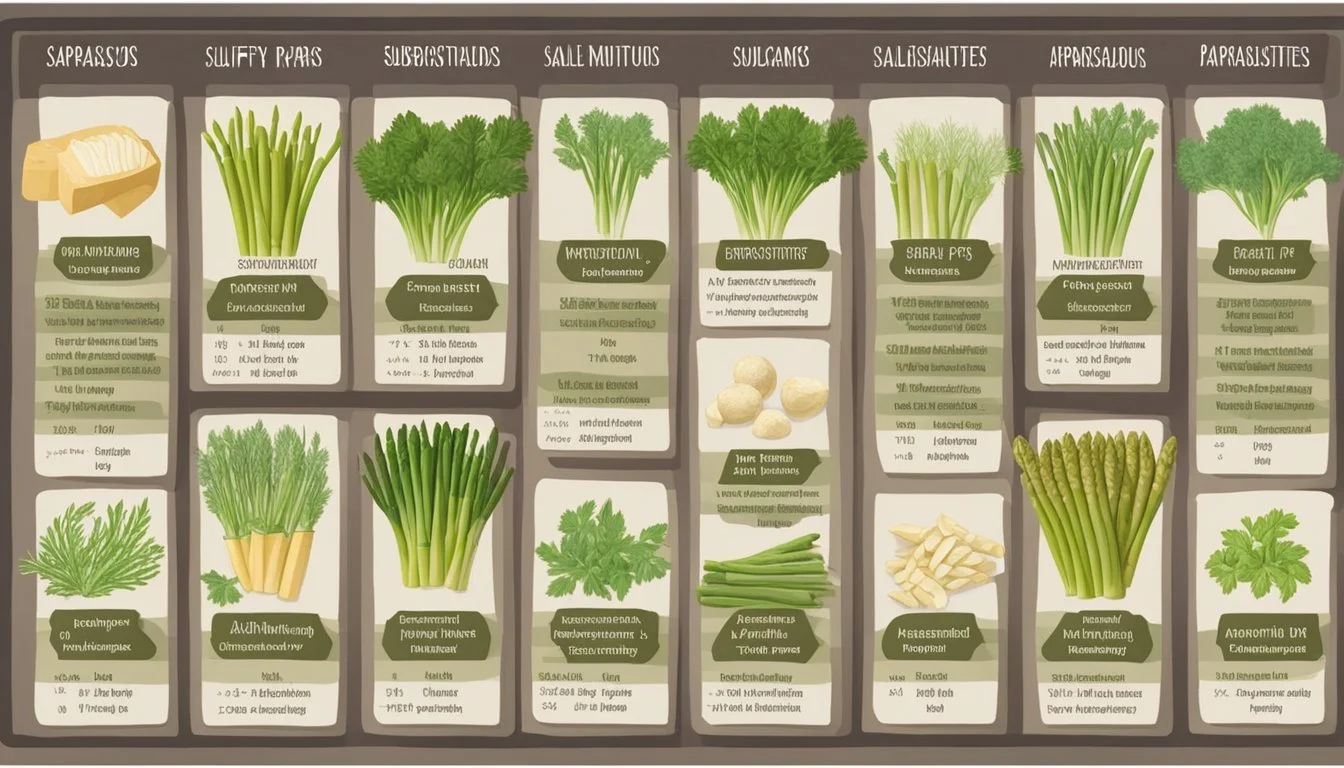Salsify Substitutes
Top Alternatives for Cooking and Baking
Finding a suitable substitute for salsify can seem challenging, but there are a few excellent options available. Parsnips are often considered the best substitute for salsify due to their similar texture and sweet flavor that intensifies upon roasting. They are also more readily available in grocery stores, making them a convenient choice.
Another good option is burdock root, which resembles salsify in appearance and texture. While burdock root has a distinct earthy and sweet flavor, it's versatile enough to complement a variety of dishes, much like salsify. Additionally, other root vegetables such as carrots, radishes, and chicory can work well as substitutes in different culinary contexts.
Cooking methods can vary, but the goal is to achieve a similar texture and flavor profile. For instance, roasting salsify or its substitutes with olive oil and seasonings can bring out their natural sweetness and enhance their compatibility with other ingredients. Whether using parsnips, burdock root, or another viable substitute, matching the cooking method to the dish can ensure a successful culinary experience.
Understanding Salsify
Salsify, a root vegetable, is prized for its unique flavor and versatility in cooking. It comes in two main varieties and offers various nutritional benefits, making it an interesting ingredient to explore.
Origin and Classification
Salsify, known scientifically as Tragopogon porrifolius, belongs to the Asteraceae family. This root vegetable is commonly referred to as "oyster plant" due to its oyster-like flavor when cooked.
There are two primary types: white salsify and black salsify (also called scorzonera or black oyster plant). Originally from the Mediterranean region, salsify has been cultivated for centuries and can be found in various parts of Europe and North America. Both types have long, tapering roots, with the black variety generally being more highly regarded for its taste and texture.
Culinary Uses
Salsify's subtle, nutty flavor works well in a variety of dishes. When cooked, it can mimic the taste of artichoke hearts, making it a versatile ingredient. It can be boiled, mashed, roasted, or sautéed, similar to how one might prepare parsnips or potatoes.
To prevent discoloration after peeling, salsify should be placed in acidulated water. It is a good source of dietary fiber, potassium, and essential vitamins and minerals, making it a nutritious addition to meals.
Common culinary uses include adding salsify to soups, stews, and gratins. Its mild yet distinctive taste also allows it to stand out in mixed vegetable dishes or even as a standalone side dish.
Preparing Salsify
Preparing salsify involves proper cleaning, peeling, and the application of various cooking techniques to achieve the best results. Its delicate taste and texture can be enhanced through methods such as roasting, boiling, or mashing.
Cleaning and Peeling
Salsify requires careful cleaning and peeling to maintain its quality. Start by scrubbing the outer skin with a vegetable brush under cold running water to remove any dirt.
To prevent browning, place the cleaned roots immediately into acidulated water—a mixture of water and lemon juice. This step preserves their color and prevents oxidation.
Peeling can be done with a standard vegetable peeler or a paring knife. The peeled roots should continually be returned to the acidulated water while you prep the remaining pieces.
Cooking Techniques
Various methods can be used to cook salsify, each bringing out unique flavors and textures. Boiling is a straightforward approach: boil the peeled salsify until tender, which usually takes about 10-15 minutes.
For roasting, preheat your oven to 425°F (220°C). Cut the salsified into uniform pieces, toss with olive oil, salt, and preferred seasonings like paprika or chili powder, and roast for 25-30 minutes until golden and crispy.
Mashing can be achieved by boiling the roots until soft and then mashing them with potatoes, butter, and salt for a smooth, creamy side dish.
Whether boiled, roasted, or mashed, salsify offers versatile preparation options that can suit a variety of dishes.
Top Salsify Substitutes
When looking for alternatives to salsify, several root vegetables can mimic its mild, earthy flavor and texture. Each substitute offers unique qualities suitable for various culinary applications.
Parsnip
Parsnips are a top substitute for salsify, offering a sweet, slightly nutty flavor. Parsnips are also root vegetables and share a similar texture when cooked. They are native to the Mediterranean region, where salsify is also believed to originate. Their versatility makes them great for roasting, mashing, or adding to soups. Cooking Tip: Slice parsnips thinly for a more even cooking experience. They pair well with spices like nutmeg and cinnamon.
Jerusalem Artichoke
Jerusalem Artichokes, also known as sunchokes, provide a mildly sweet, nutty flavor. These tubers are rich in inulin, offering both a crunchy raw texture and a tender cooked consistency. While sometimes confused with artichokes, they belong to the sunflower family. Usage: Great for gratins, purees, or roasting. Their unique texture can add a surprising twist to meals focused on root vegetables.
Turnip
Turnips have a slightly spicy, tangy flavor that can add depth to dishes typically featuring salsify. Turnips are widely available and offer a firm texture that softens when cooked. They are ideal for mashes, stews, and casseroles. Cooking Suggestion: Peel turnips thoroughly to remove their bitter outer layer. They can be combined with other root vegetables for a complex flavor profile.
Black Radish
Black Radishes are distinguished by their dark skin and sharp, peppery taste. Though more pungent than salsify, they can bring an intense flavor to various dishes. Suitable for both raw salads and cooked applications, black radishes can be roasted or sautéed. Preparation Tip: Slice them thinly to temper their strong flavor. Pairing with milder vegetables can balance their intensity.
Substitutes for Specific Dishes
In various recipes, salsify can be replaced with select root vegetables that match its flavor and texture. These alternatives work well in both fresh salads and hearty soups or stews, depending on the preparation method.
Salad Alternatives
For fresh salads, celeriac and white carrot are fitting substitutes for salsify. Celeriac, with its mild celery-like flavor, pairs well with potatoes in a variety of salad recipes. Its slight sweetness enhances the taste of the other ingredients without overpowering them.
White carrot, closely resembling salsify in texture, offers a similar crunch. It provides a subtly sweet, slightly bitter taste that complements green vegetables and dressings well. Using white carrots in place of salsify maintains the dish’s integrity while providing a familiar yet distinct flavor profile.
Options for Soups and Stews
Salsify can be effectively substituted in soups and stews with vegetables like parsnips and carrots. Parsnips share a sweet flavor when roasted, which intensifies and melds seamlessly with broths and other root vegetables. Their slightly nutty taste offers depth to stews.
Carrots, noted for their similar size and shape to salsify, require minimal adjustments in recipes. They cook slightly faster but offer a complementary sweetness and firmness that hold up well in long-simmered dishes. Incorporating canned salsify as a last resort provides an artichoke-like texture when fresh salsify isn't available.
Nutritional Comparison
Salsify and its potential substitutes offer various nutritional benefits that make them valuable in diet management. Notably, they provide significant amounts of fiber, vitamins, and minerals critical for overall health.
Health Benefits of Alternatives
Burdock root, a notable substitute for salsify, is rich in inulin, a dietary fiber beneficial for digestive health and blood sugar control. It is also a good source of potassium, vitamin C, and iron, which are essential for maintaining healthy bodily functions and boosting the immune system.
Sweet potatoes, another alternative, are particularly high in Vitamin A, providing 107% of the daily requirement per serving. They contain antioxidants that help fight free radicals, reducing oxidative stress in the body. Furthermore, sweet potatoes are rich in fiber and potassium.
Dietary Considerations
When substituting salsify, it's important to consider the variations in calories and macronutrient compositions of the alternatives. For instance, sweet potatoes have more calories compared to salsify, making them more suitable for energy-dense diets.
Burdock root, with its high inulin content, may offer better fiber intake, aiding in digestive health. However, for those managing iron levels, both salsify and burdock root can be advantageous due to their iron content.
Vitamin C is another consideration, where both burdock root and salsify can contribute to meeting daily requirements. Adjusting portion sizes appropriately can help balance nutrient intake while avoiding excess consumption.
Selecting and Storing Substitutes
When selecting and storing substitutes for salsify, it's important to consider both the taste and storage requirements. Different vegetables can offer unique flavors while proper storage ensures freshness and longevity.
How to Choose the Right Substitute
Choosing the right substitute depends on the recipe and desired flavor. Celeriac is a popular choice due to its mild, celery-like taste. It's great for mashing or roasting. Parsnips offer a sweet flavor that intensifies when roasted, making them an excellent complement to meats and root vegetable dishes.
Turnips provide a peppery flavor and are versatile for soups and stews. Burdock root has a sweet and earthy taste and works well in stir-fries. Carrots can be used for their sweetness and versatility.
Storage Tips
Proper storage is essential for maintaining the freshness of substitutes. Celeriac should be refrigerated, ideally in a plastic bag to maintain moisture. Parsnips also benefit from cool storage, placed in the vegetable crisper drawer.
Turnips should be stored in a cool, dark place or refrigerated. Burdock root can be wrapped in a damp cloth and stored in the fridge to retain its moisture. Carrots should be kept in the refrigerator, preferably in a perforated plastic bag to maintain humidity. This approach prevents drying out and extends their shelf life during the winter months.
Cooking Tips for Salsify Alternatives
When using salsify substitutes, attention to cooking times and flavor pairings can make all the difference. Below are essential tips for adjusting cooking times and enhancing flavors.
Adjusting Cooking Times
Different root vegetables require varying cooking times. Carrots, for example, need a few minutes less to cook compared to parsnips or salsify due to their softer texture.
To ensure even cooking, cut substitutes like celeriac into uniform pieces. Boiled and mashed celeriac works well and pairs nicely with butter, salt, and pepper. Roasting is another excellent method. For instance, preheat the oven to 425°F, scrub and trim the chosen vegetable, and cut it into 1-inch pieces. Toss with olive oil, salt, and pepper before roasting.
Flavor Pairings and Enhancements
Balancing flavors is key. Celeriac has a subtle celery flavor, so pairing it with lemon or vinegar can brighten its earthy tones. Combining garlic and parsley enhances its flavor profile in roasted dishes.
For carrots, their natural sweetness complements butter and a dash of brown sugar. Adding paprika or chili powder can give a savory twist, especially when roasted. These simple enhancements ensure that whatever substitute you choose, the dish remains flavorful and satisfying.
Salsify in Different Cuisines
Salsify, a versatile root vegetable, features prominently in a variety of dishes across different cuisines. Its unique flavor, often likened to artichoke or oysters when cooked, adds depth and interest to many culinary traditions.
European Cuisine
In European cuisine, salsify enjoys a notable presence, especially in French and Spanish recipes. In France, it is often included in stews and casseroles, providing a subtle, earthy flavor. The classic French preparation involves peeling, slicing, and simmering salsify with a touch of butter and cream.
Spanish salsify, known as "salsify espanola," is typically grilled or roasted with olive oil, garlic, and herbs. It serves as both a side dish and a key component in vegetable medleys. The sweet flavor of roasted salsify complements meats like lamb and beef.
Asian Influence
Salsify's entry into Asian cuisine is less traditional but increasingly popular. In countries like Japan and South Korea, chefs experiment with salsify in various fusion dishes. It is commonly used in tempura recipes, where the root is battered and fried, highlighting its delicate flavor and crispy texture.
Asian-inspired salads often feature thinly sliced salsify, paired with soy-based dressings and fresh herbs. The subtle sweetness and crunch of raw salsify make it a natural addition to these dishes. Chefs also incorporate salsify into stir-fries, blending it with other vegetables and savory sauces for a unique twist on classic recipes.
Salsify Cultivation and Growth
Salsify (Tragopogon porrifolius), also called goatsbeard or vegetable oyster, thrives in well-prepared soil and requires thoughtful care from planting to harvest. Key steps include proper planting techniques and attentive harvesting methods to prevent damage and ensure optimal growth.
Planting and Care
Planting salsify begins with choosing a location that receives full sun. The soil should be rich in organic matter and well-worked to a depth of 8 to 12 inches to accommodate the long roots. It's important to remove stones and lumps from the soil to prevent root deformities.
Plant the seeds about an inch deep, spacing them approximately nine inches apart. Consistent moisture is crucial during germination, so keep the soil moist but not waterlogged. For best results, salsify prefers a soil pH between 6.0 and 6.8.
Regular weeding is necessary to minimize competition for nutrients. Mulching can help retain soil moisture and reduce weed growth. Maintain a steady watering schedule, especially during dry periods, to support healthy root development.
Harvesting Tips
Salsify roots are usually ready for harvest when they reach about 12 inches in length, which typically takes between 120 to 150 days. It's essential to handle the roots carefully to avoid damage, as injured roots don't store well.
Use a fork to dig down beside the root and gently lift it from the soil. Avoid pulling directly on the plant to prevent breaking the root. Cleaning the roots immediately after harvesting and allowing them to dry can help with storage.
To store salsify, place the roots in a cool, dry location. Avoid storing them in excessively humid conditions, which can lead to rot. With proper care during harvesting and storage, salsify can maintain its quality for an extended period.









